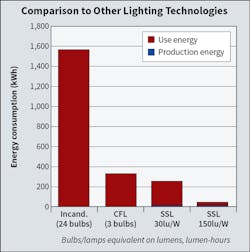Smart lighting has been a topic of conversation for quite some time. There are a number of different strategies available today, but with choice comes confusion. Without a single standard or approach being taken on the controls front, many customers aren’t willing to move forward for fear of choosing the wrong platform. However, the benefits of having a building-wide lighting control strategy have become too numerous to ignore.
Bluetooth mesh is rapidly gaining momentum as a standard that can handle lighting control and other data, and manufacturers are starting to add Bluetooth mesh capabilities to their LED luminaires. Bluetooth mesh is attractive for wireless lighting controls because it is open and secure. Using Bluetooth mesh as a communications platform is also paving the way for additional building automation systems and controls.
Bluetooth is a well-defined and thoroughly documented standard, which means vendors who adopt Bluetooth can guarantee interoperability. Adopting Bluetooth mesh not only provides a surefire way to connect luminaires, but it also is guaranteed to interoperate with other Bluetooth devices.
Bluetooth Mesh Structure
Bluetooth mesh is structured as a “flood network,” communicating with all devices within its vicinity at once. Bluetooth mesh sends every incoming data packet to every outgoing connection and shares it across a lattice of Bluetooth devices (Fig. 1). Each packet can carry up to 384 bytes of data, although most messages will fit in an 11-byte frame. Eleven bytes is more than enough for machine-to-machine (or luminaire-to-luminaire) communications. Each packet includes one byte of opcode for special messages, 2 bytes for standard messages, or 3 bytes for vendor-specific messages, as well as a source and destination address, and sequence numbers to prevent replay attacks.
Bluetooth mesh is scalable and fast (up to 1 Mb/sec data transmissions). The mesh design ensures there is no single point of failure, which is why the Bluetooth mesh topology is more robust and reliable for wireless communications. All devices that are qualified by the Bluetooth SIG are guaranteed to be interoperable, and the mesh design is self-healing so you can add or remove devices without disruption — or if a signal is blocked the mesh automatically reroutes the data to compensate.
What makes Bluetooth mesh ideal for lighting controls is it supports two-way communications (i.e., the same wireless mesh network can be used to commission new luminaires and upgrade firmware as well as to monitor luminaire conditions and performance). For example, using Bluetooth mesh communications, you can measure ambient light and send the data to a luminaire, which, in turn, can get brighter or dimmer depending on the ambient light target. And you have a huge established base of Bluetooth-enabled devices that can be used to run lighting control software, such as computers, tablets, and smartphones.
Once you have two-way communications in place, you can use the same infrastructure to measure and manage other building conditions, such as environment or room occupancy. Since Bluetooth can handle different types of data traffic, luminaires connected using Bluetooth mesh also can be used to send building automation data as well.
A Secure Wireless Control Network
Another reason Bluetooth mesh is gaining acceptance is security. Implementing a wireless, two-way building control system could give cybercriminals access to building controls or even a back door to access sensitive business records. Bluetooth mesh was developed with security in mind and has encryption and authentication built in.
All Bluetooth data communications are encrypted. Bluetooth mesh uses at least two decryption keys: 1) network keys that are specific to the network; and 2) application keys that are specific to a function, such as activating a luminaire as opposed to programming a luminaire. For authentication, Bluetooth uses a challenge-response approach so each device included in the mesh is either a verifier seeking to validate device identity or a claimant that needs to prove its identity. Verification is made using a Bluetooth link authentication key. Bluetooth mesh encryption and authentication are very advanced, and it is virtually impossible to break into a Bluetooth mesh control grid.
For added security, Bluetooth mesh can be divided into subnets, each with its own encryption and authentication schemas. Its architecture has also been designed to defend itself from malicious data repeats and delays, stolen device credentials, and other threats.
Adding the Internet of Things
A network of Bluetooth mesh-connected luminaires makes the ideal skeleton for a building control system, especially if you use it as a foundation protocol. Sensors mounted in luminaires can handle all sorts of data traffic and send it back to a central control console or dashboard, and since lighting is everywhere it makes sense to use it for building controls.
However, while Bluetooth mesh can handle any type of data traffic, IP controllers are not designed to interoperate with other building management protocols. For example, if you want to mix DALI (Digital Addressable Lighting Interface) for lighting dimming controls with a building automation system (BAS) protocol such as BACnet for HVAC controls, you need a common framework such as Niagara to make the different systems interoperable.
Controls standards such as ZigBee, DALI, and BACnet can interoperate as hierarchical standards (Fig. 2). Bluetooth is a full stack solution, with all layers defined. For example, Bluetooth application layer provide specific device commands at a higher protocol layer while the Bluetooth radio provides a machine-to-machine communications path at a lower layer. Once you establish a link at the physical and data link layer, you can add whatever application-specific instructions you want at a higher layer.
As more vendors embrace Bluetooth mesh to connect LED luminaires, you can expect to see wireless lighting controls become more common, especially in LED lighting retrofit projects. And as more manufacturers incorporate sensors with Bluetooth mesh in their LED luminaires, intelligent luminaires will start to form the foundation for integrated building controls and applications utilizing Bluetooth such as asset tracking using Bluetooth beacons.
Garcia is VP of product management and global engineering for Fulham, Co., Hawthorne, Calif. He can be reached at [email protected].
Sidebar: The Benefits of a Lighting Control System
Implementing effective, centralized lighting controls can represent a huge cost savings. The U.S. Energy Information Administration says that 17% of energy used in commercial buildings is for lighting (see Figure). Those commercial building managers who have already retrofitted building lighting with LEDs saw energy consumption drop from 38% to 17% between 2003 and 2012. In fact, research firm Gartner predicts smart lighting could ultimately reduce energy consumption by as much as 90%.
Saving energy and money is only one benefit of smart lighting. A smart lighting ecosystem also serves as the perfect skeleton for other building controls. With a common communications system in place, you can apply different types of controls, not just lighting. Luminaires are evenly spaced in a commercial building so they are the ideal location for mesh network nodes and sensors, which can monitor and manage building conditions, security, emergency response, and more.






